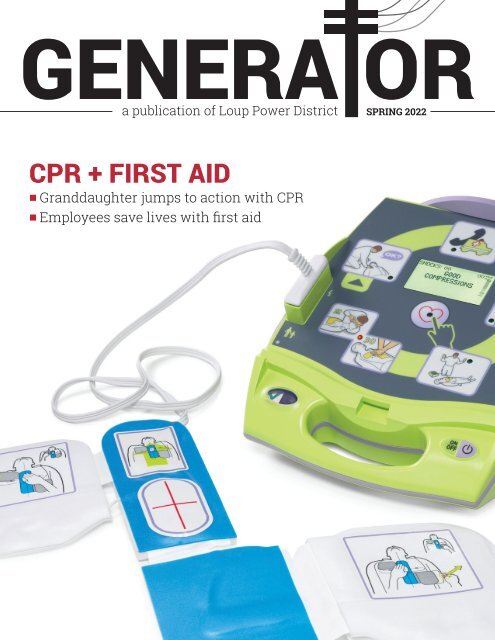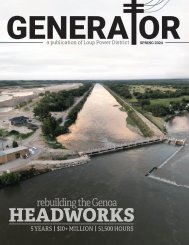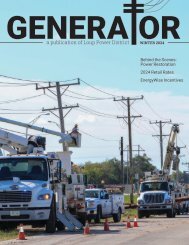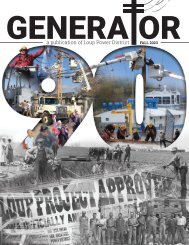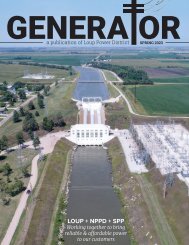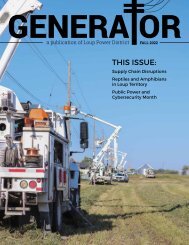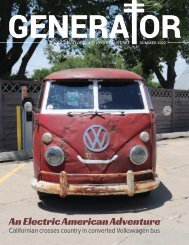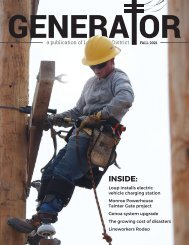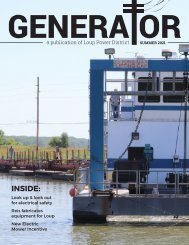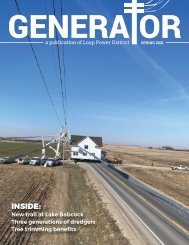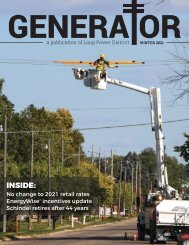Generator — Spring 2022
In this issue of the Loup Power District Generator: a granddaughter saves her grandpa's life by jumping to aid with CPR; Loup employees save lives using CPR, AED, and first aid skills; Lineworker Appreciation Day; Loup delivers lease payments and in-lieu-of-tax payments; and more.
In this issue of the Loup Power District Generator: a granddaughter saves her grandpa's life by jumping to aid with CPR; Loup employees save lives using CPR, AED, and first aid skills; Lineworker Appreciation Day; Loup delivers lease payments and in-lieu-of-tax payments; and more.
Create successful ePaper yourself
Turn your PDF publications into a flip-book with our unique Google optimized e-Paper software.
GENERA OR<br />
a publication of Loup Power District SPRING <strong>2022</strong><br />
CPR + FIRST AID<br />
• Granddaughter jumps to action with CPR<br />
• Employees save lives with first aid
BOARD OF DIRECTORS<br />
Alan Drozd<br />
Chairman<br />
Steve Heesacker<br />
First Vice Chairman<br />
Robert Cerv<br />
Second Vice Chairman<br />
Jim Donoghue<br />
Secretary<br />
Dick Tooley<br />
Treasurer<br />
Rich Aerni<br />
Mike Fleming<br />
Ross Knott<br />
Chris Langemeier<br />
Larry Zach<br />
EXECUTIVE STAFF<br />
Neal Suess<br />
President/CEO<br />
Walt Williams<br />
Vice President,<br />
Accounting & Finance/CFO<br />
Todd Duren<br />
Vice President,<br />
Corporate Services<br />
Korey Hobza<br />
Vice President, Engineering<br />
Dan Hellbusch<br />
Vice President, Operations<br />
The Loup <strong>Generator</strong> is<br />
published quarterly<br />
as a service for Loup<br />
employees, families,<br />
friends, and associates.<br />
For feedback, story ideas<br />
and submissions, contact:<br />
Stacy Wemhoff<br />
Communications Coordinator<br />
402-562-5711<br />
swemhoff@loup.com<br />
• Buy Nebraska Shopping<br />
Experience ($100 gift card)<br />
• Family passes to Pioneer Village,<br />
the Hastings Kool-Aid Museum,<br />
The Archway, and Edgerton Explorit<br />
Center<br />
• Niobrara River float trip for four<br />
• Two-night stay at Chadron State<br />
Park and a visit to Carhenge<br />
Nebraska is the only state in the nation that is<br />
100% publicly powered.<br />
In other words, we’re the only state where every customer<br />
receives electric service from a local, publicly owned utility.<br />
Now, while others might consider this an odd thing to brag<br />
about, we all should be proud of the benefits public power<br />
brings to the quality of life here in Nebraska.<br />
That’s why the state’s public power utilities are giving away<br />
some Uniquely Nebraska Prizes.<br />
To Win<br />
• Bed & breakfast accommodations<br />
to visit Ashfall Fossil Beds<br />
• Family pass to the Henry Doorly<br />
Zoo & Aquarium<br />
• One-night stay on the riverboat in<br />
historic Brownville<br />
• Year’s worth of Runza sandwiches<br />
($100 gift card)<br />
• Uniquely Nebraskan T-shirts<br />
Follow Loup’s Facebook page Comment, share, and tag friends on the “Uniquely<br />
Nebraskan” campaign posts Be sure to use #NebraskaProud in the post.<br />
Random winners will be drawn for the “Uniquely Nebraska” prizes and T-shirts. Winners will be<br />
contacted for instructions on how to claim prizes that be awarded by the winner’s local public<br />
power utility.<br />
visit publicpowered.com for another chance to win<br />
and learn about the benefits of public power.<br />
Contest is open to customers served by Nebraska Public Power District and its wholesale utility customers.<br />
2 | GENERATOR
pReSIDeNT’S MessAGe<br />
Public Power systems work<br />
for customers & communities<br />
Nebraska is a 100 percent public power state,<br />
which makes it unique within the United States.<br />
Let’s take a second to explore what this means.<br />
First, what is a public power system? Well,<br />
this means the system is owned by its consumers,<br />
or customers. The consumers elect the members<br />
(Board of Directors, City Council, etc.) who<br />
oversee the public power system. Those elected<br />
officials are charged with developing the policies<br />
of the entity, choosing the management, and<br />
maintaining the overall fiscal management of the<br />
public power utility. This includes developing<br />
budgets and setting rates. The consumers can<br />
select who they want to represent them as an<br />
official; therefore, the consumer has control.<br />
Additionally, public power systems are not-forprofit<br />
entities. Any surplus that is made from year<br />
to year goes back into rebuilding and repairing the<br />
electric system. There are no shareholders looking<br />
to make a profit on their investment. This is one of<br />
the major reasons public power rates are generally<br />
lower than those of other type of entities, such as<br />
an investor-owned utility.<br />
Public power systems can also range in size.<br />
Just within our territory you have (1) a small<br />
city-owned entity, the Schuyler Department<br />
of Utilities; (2) two medium-sized utilities in<br />
Cornhusker Public Power District and Loup Power<br />
District, serving a four-county area; and (3) a large<br />
statewide organization in Nebraska Public Power<br />
District.<br />
Public power systems work for the communities<br />
we serve. In addition to running the electric<br />
system, many of us sit on boards of a variety of<br />
other government entities and on local volunteer<br />
boards, such as Chamber of Commerce, schools,<br />
YMCA, and others.<br />
Additionally, we are better able to respond<br />
quickly to outages and concerns because we have<br />
offices in many of the communities we serve. Since<br />
we live in these areas, we understand what is going<br />
on and can be there to respond much faster than<br />
an organization that might have to travel a long<br />
way to provide service.<br />
Now that you have a better idea of what a public<br />
power system is, what makes Nebraska so unique?<br />
As I said at the beginning, Nebraska is a 100<br />
percent public power state. Now, almost all states<br />
have public power systems (Hawaii is the only<br />
state that does not). However, Nebraska is the only<br />
state in which every electric customer is served by<br />
a public power system.<br />
This was established by the State of Nebraska<br />
Legislature back in the 1930s, when many rural<br />
consumers were not getting the service they<br />
needed. The Legislature set up the system for an<br />
all public power state, and that is the way things<br />
stay today.<br />
We are very excited to be a part of this system<br />
and to bring you safe, reliable, low-cost electricity<br />
for your needs. The Loup Power District Board of<br />
Directors and employees are happy to serve you<br />
and we look forward to continuing to do this in the<br />
future.<br />
NEAL SUESS<br />
President/CEO<br />
SPRING <strong>2022</strong> | 3
Dan Strong was mowing the lawn at his daughter’s<br />
house in Iowa last May.<br />
He and his wife, Janice, were in town for a Grandparents<br />
Day program and he decided to help out with a<br />
few chores before they headed home to Genoa.<br />
After the lawn was finished, he offered to clean his<br />
granddaughter’s car and check<br />
it over before she went back to<br />
college.<br />
“I felt fine,” Dan said.<br />
But within a few minutes, he<br />
was fighting for his life <strong>—</strong> a life<br />
that he owes to his granddaughter,<br />
Hannah Tripp.<br />
***<br />
Hannah remembers hearing a<br />
thud and running over to check on<br />
Dan. She found him lying on the<br />
ground, moving his arm.<br />
“I thought he just broke his<br />
wrist, but he wasn’t responsive,”<br />
she said.<br />
She yelled for Janice, asking<br />
her to dial 911. Dan briefly came<br />
around and said he didn’t need<br />
an ambulance and got up to sit on a stool before<br />
going pale. He started to fall and Hannah’s brother,<br />
Garrison, caught him.<br />
Hannah got on the phone and reported her assessment<br />
to the 911 operator and asked if she should start<br />
CPR. After an affirmative answer, the operator asked if<br />
she should walk Hannah through the process.<br />
Hanna told the operator she knew CPR <strong>—</strong> she<br />
had completed her CPR recertification a few months<br />
earlier.<br />
When the ambulance arrived, the paramedics took<br />
over CPR and began using an Automatic External<br />
Defibrillator (AED).<br />
“They had to shock me three times in order to bring<br />
me back around,” Dan said. “I crashed again in the<br />
ambulance and when I arrived at the ICU.”<br />
***<br />
Dan was stabilized at a critical care hospital where<br />
his daughter, Brandy, worked. Then he was transferred<br />
still going<br />
STRONG<br />
GRANDDAUGHTER SAVES GRANDPA’S LIFE WITH CPR<br />
“<br />
They had to shock me<br />
three times in order to<br />
bring me back around.<br />
I crashed again in the<br />
ambulance and when I<br />
arrived at the ICU.<br />
to a larger hospital in Waterloo, Iowa. Initially, the<br />
doctors thought he had a heart attack, but there was<br />
no blockage.<br />
“My heart just got out of rhythm and it just shut<br />
down,” Dan said.<br />
He had a cardiac arrest. The condition usually<br />
results from a problem with the<br />
heart’s electrical system, which<br />
disrupts the heart’s pumping<br />
action and stops blood flow to the<br />
body.<br />
Dan had a pacemaker and<br />
defibrillator implanted in his chest<br />
while in the hospital. The device<br />
tracks the heart rate and delivers<br />
an electric shock to restore normal<br />
heartbeat if it detects a life-threatening<br />
arrhythmia.<br />
He spent a week in intensive<br />
care and a week in the heart unit<br />
at the hospital. That was followed<br />
by a week in a rehab center and<br />
a week living with his daughter<br />
before he was cleared to travel back<br />
home.<br />
He was also given a list of things he should not do.<br />
On that list were welding and using a grinder.<br />
During those weeks of recovery, Dan considered<br />
how these new precautions would affect his job at<br />
Loup Power District’s Genoa Headworks.<br />
“I wasn’t going to ask someone else to do my job,”<br />
he said. “So, I decided that I would retire.”<br />
***<br />
Dan’s career with Loup Power District began in<br />
1986 following layoffs at Lindsay Manufacturing.<br />
He was looking for a new job and heard there was<br />
an opening at the Genoa Headworks. He got the job as<br />
a Maintenance Man and it soon became evident that<br />
he had the technical skills for the job.<br />
At the time, most major repairs to Headworks<br />
equipment made their way to mechanics at the<br />
Columbus Service Center. Dan showed he could<br />
handle most of those jobs, helping him earn a<br />
promotion to Maintenance Technician in 1988.<br />
4 | GENERATOR
Strong helped repair the Genoa Headworks following<br />
a 2019 storm that caused canal breaches and flooding.<br />
RED CROSS AWARD<br />
Dan Strong’s granddaughter, Hannah Tripp, received an award from the<br />
American Red Cross for her lifesaving actions following his cardiac arrest.<br />
Dan said he developed a daily routine over his 35<br />
years at the District. He is grateful that he had supervisors<br />
who understood that he would complete his<br />
required tasks without a lot of supervision.<br />
The best part of the job was getting to work with a<br />
great bunch of coworkers.<br />
He is grateful for the opportunity to work for Loup.<br />
“I couldn’t ask for a better company to work for,” he<br />
said.<br />
***<br />
Retirement is always a big change, but Dan has<br />
plenty of projects on his agenda.<br />
“There’s plenty to do on the acreage,” he said.<br />
He and his wife both enjoy working on their garden<br />
at their home north of Genoa. They would like to<br />
travel. Nashville is on their destination list.<br />
Dan also does some mechanic work like tune-ups,<br />
brake jobs and other service work for clientele he’s<br />
had for years.<br />
“They’re good, loyal customers,” he said. “I’m<br />
thankful for that, too.”<br />
The most important thing on his list is spending<br />
time with his five grandchildren.<br />
Hannah has since graduated from Central College<br />
in Pella, Iowa, with a degree in Exercise Science. She<br />
first earned her CPR certification as a freshman.<br />
She realized that certification was about to expire<br />
and classes were free at college. So she took classes<br />
for recertification in late 2020, never imagining that<br />
the skills she learned would help save the life of her<br />
grandfather a few months later.<br />
Both Dan and Hannah hesitate to think what the<br />
outcome could have been. Hannah knows how<br />
important CPR skills are and encourages everyone to<br />
take classes. Dan is grateful she was there that day.<br />
“I am fortunate everything worked out and the<br />
Almighty was taking care of me,” he said.<br />
SPRING <strong>2022</strong> | 5
LIFE<br />
SAVERS<br />
Heart attacks. Choking. Accidents.<br />
Loup Power District provides CPR, AED, and First Aid<br />
classes for employees every two years. They are taught to<br />
prepare for the unexpected. These employees used those<br />
skills to save the lives of family and strangers.<br />
• RON CHRISTO<br />
Cedar Rapids Local Superintendent<br />
It’s been 30 years, but Ron Christo can still<br />
remember the sound of the garage door motor as it<br />
tried to close.<br />
He can still remember the horrifying realization<br />
that it was grinding because his toddler was stuck<br />
under it.<br />
“She was trapped face down,” he said. “The<br />
door was across the back of her neck,” he said.<br />
Christo hit the stop button twice <strong>—</strong> once to stop<br />
the door and once to open it. He rolled her over and<br />
there was no response.<br />
“She was dead,” he said.<br />
***<br />
Christo started his career at Loup Power District<br />
in 1985 and attended regular CPR and first aid<br />
training sessions as required.<br />
He never thought he would need to jump into action to help anyone <strong>—</strong><br />
especially not one of his own kids.<br />
Melissa, the toddler, was running in and out of the garage that day. He<br />
didn’t think twice about hitting the button to close the garage door. He never<br />
knew the safety mechanism was broken.<br />
But when he rolled her over and saw that she wasn’t breathing, he reacted<br />
with a combination of instinct and training.<br />
“I knew I had to do something,” Christo said.<br />
He started CPR and wondered if he was doing it right because it didn’t<br />
seem like the air was getting into the lungs.<br />
But he kept at it until he could hear the air coming back out of the lungs.<br />
“It’s just like in CPR training when they tell you it sounds like air leaving a<br />
balloon,” Christo said. “That’s exactly what it sounded like.”<br />
Even with that positive sign, Melissa did not respond.<br />
“I remember shaking her and screaming at her at the top of my lungs,” he<br />
said. “Then she gasped for air.”<br />
Melissa was alive and breathing when the ambulance arrived. She stayed<br />
at Children’s Hospital in Omaha for a couple of days and fully recovered.<br />
Christo knows there could have been another outcome.<br />
“My daughter would have died if I didn’t know CPR,” he said.<br />
• FOR MORE INFORMATION<br />
Don’t wait for an emergency to happen to prepare. Now is the time to gather<br />
essential supplies, learn self-help skills, and build the self-confidence you<br />
need to respond quickly and constructively in a crisis.<br />
Learn more at the CDC’s website: bit.ly/CDCaction<br />
• TIM RAMAEKERS<br />
Dist. Substation Meter<br />
Maintenance Superintendent<br />
Tim Ramaekers<br />
and his wife, Michelle,<br />
were out for an anniversary<br />
dinner when<br />
they heard coughing.<br />
The victim was out<br />
of sight, but Michelle<br />
urged him to check<br />
on her and see if she<br />
needed help. He went<br />
around the corner and<br />
saw an elderly couple.<br />
The woman was in<br />
obvious distress.<br />
“She was giving<br />
the universal sign of<br />
choking with her hands around her neck,” he<br />
said.<br />
Ramaekers asked if he could help since he<br />
knew the Heimlich Maneuver and first aid. The<br />
victim’s husband urged him to help.<br />
“I did the Heimlich maneuver a couple of<br />
times and nothing happened and she was<br />
starting to pass out,” Ramaekers said.<br />
He knew he had to use more force. “I was a<br />
little scared and apprehensive at first,” he said.<br />
“But I realized she was in danger of dying.”<br />
And with that decision, he dislodged a piece<br />
of meat that was choking her.<br />
“She was able to breathe right away and all<br />
the life came back into her,” he said. “It was<br />
incredible.”<br />
The woman took a few minutes to regain her<br />
composure and then hugged him.<br />
“She was so thankful . . . It was pretty<br />
moving,” Ramaekers said.<br />
The couple came over to offer their gratitude<br />
once more before leaving the restaurant that<br />
night.<br />
Ramaekers said the experience proves the<br />
importance of first aid training <strong>—</strong> you never know<br />
when you’ll need to jump to action to save a life.<br />
“I didn’t expect to give the Heimlich maneuver<br />
in a restaurant to someone I didn’t know,” he<br />
said.<br />
6 | GENERATOR
• SCOTT SOKOL<br />
Albion Division Superintendent<br />
“Heart attack! Heart attack!”<br />
Scott Sokol will never forget<br />
hearing the panic-filled yells as he<br />
was out shopping.<br />
But it didn’t take long for him to<br />
respond with help.<br />
“You go into auto pilot,” he said.<br />
***<br />
Sokol was in Omaha shopping<br />
with his family when he heard those<br />
words. He ran over to find a man on<br />
the floor.<br />
“You could look at him and tell he<br />
wasn’t breathing,” Sokol said. “His<br />
pupils were fixed and dilated.”<br />
He checked for a pulse and followed the ABCs <strong>—</strong> airway,<br />
breathing, and circulation.<br />
Then two store employees ran over with an AED (automated<br />
external defibrillator). Together, they opened his shirt,<br />
followed the AED prompts, and shocked the victim.<br />
“We shocked him one time and he was back among the<br />
living.”<br />
Within a couple of minutes, an ambulance arrived and the<br />
EMTs put him on oxygen. He was breathing.<br />
Sokol, a former EMT and current fire department volunteer,<br />
said it’s important to know basic first aid.<br />
A lot of people are scared to jump in and help in an emergency,<br />
but knowing the basics can help alleviate that fear.<br />
“It’s good to know these things.”<br />
• RICK PRATER<br />
Supervisor of Safety & Training<br />
Rick Prater was working outside<br />
when he heard his wife screaming.<br />
“She ran to me carrying my<br />
daughter,” he said.<br />
Brianna was 2 or 3 at the time.<br />
Her face was red and she was<br />
choking.<br />
He looked in her mouth and<br />
couldn’t see any obstruction. She<br />
was small enough that he was able<br />
to hold her on his forearm and he<br />
gave her five back blows.<br />
She quit coughing and was about<br />
to pass out. After another round of<br />
blows, he checked her mouth again<br />
and could see coins obstructing her<br />
airway.<br />
Prater knew it was risky to reach in her throat, but he also<br />
had to act quickly before she lost consciousness. He followed<br />
his instincts and reached in Brianna’s throat to sweep out the<br />
coins <strong>—</strong> a dime and a nickel.<br />
She spit up and started coughing and breathing again.<br />
“It was pretty nerve-racking,” he said.<br />
• JARED HOEFELMAN<br />
Journeyman Lineman<br />
Jared Hoefelman and his wife,<br />
Molly, were visiting with a family<br />
member one evening.<br />
His relative admitted that he<br />
wasn’t feeling very well <strong>—</strong> his chest<br />
was tight.<br />
Hoefelman was immediately<br />
concerned.<br />
“I had just taken the CPR and first<br />
aid training about two weeks before,”<br />
he said.<br />
So, Hoefelman asked for<br />
additional symptoms and questioned<br />
if his jaw or shoulders were tight.<br />
The relative responded that his<br />
jaw and shoulders were hurting.<br />
Hoefelman told him these were sure signs of a heart attack.<br />
The relative laughed it off initially, saying he’d go to the<br />
hospital in the morning if he still felt bad.<br />
But Hoefelman insisted that they should go to the hospital<br />
and won out after about 10 minutes of convincing.<br />
On the way to the hospital, the relative admitted that it was<br />
probably a good idea because he was starting to feel worse.<br />
An EKG at the hospital confirmed he was having a heart<br />
attack. An artery was blocked and he was flown to Omaha that<br />
night for surgery.<br />
Hoefelman’s relative is thankful that they happened to visit<br />
that night.<br />
“A lot of people go to sleep and don’t wake up,” Hoefelman<br />
said. “It was a close call.”<br />
Hoefelman said he knew the general signs of a heart attack<br />
before working for Loup Power District, but would have never<br />
known the extra details he learned at the course offered to<br />
employees by Loup.<br />
“I think the CPR and first aid course is a great benefit,”<br />
he said.<br />
HEART ATTACK SYMPTOMS<br />
• Chest pain or discomfort<br />
• Shortness of breath<br />
• Pain or discomfort in the jaw, neck, or back<br />
• Pain or discomfort in one or both arms or shoulders<br />
• Feeling weak, light-headed, or faint<br />
HEART DISEASE FACTS<br />
• In the United States, someone has a heart attack<br />
every 40 seconds.<br />
• Every year, about 805,000 people in the United<br />
States have a heart attack.<br />
• About 1 in 5 heart attacks is silent<strong>—</strong>the damage is<br />
done, but the person is not aware of it.<br />
• Heart disease is the leading cause of death for men<br />
and women in the United States.<br />
<strong>—</strong> Source: Centers for Disease Control and Prevention<br />
SPRING <strong>2022</strong> | 7
you’ve got<br />
friends in<br />
HIGH<br />
PLACES<br />
8 | GENERATOR<br />
Kyle AINSWORTH<br />
Roy BABB<br />
Adam BABL<br />
Mike BRABEC<br />
Paul BURBACH<br />
Ron CHRISTO<br />
Jacob CZARNICK<br />
Chase DAVIS<br />
Tony DUBAS<br />
Dale GASPER<br />
Brian HERMAN<br />
Jared HOEFELMAN<br />
Joe HUBENKA<br />
Guy IMUS<br />
Tyler KLAAHSEN<br />
Cam KNOPIK<br />
Trent KONWINSKI<br />
Michael LANGE<br />
Alvin MEYER<br />
Dave MEYER<br />
Connor NEAL<br />
Tim NOVICKI<br />
Sage PENNY<br />
Dan QUINN<br />
Brandon RAMAEKERS<br />
Beau SCHOMMER<br />
Dave SHANNO<br />
Josh SIEBRANDT<br />
Scott SOKOL<br />
Andy WALLIN<br />
Tommy WEMHOFF<br />
Tom WOOD<br />
Andy YRKOSKI<br />
Dominic ZOUCHA
You’ve probably noticed Loup’s crews out and<br />
about, working on power lines and other electrical<br />
equipment in our communities. It’s no secret that a<br />
lineworker’s job is tough <strong>—</strong> but it’s an essential job<br />
that is often completed in challenging conditions.<br />
APRIL 11<br />
LINEWORKER<br />
APPRECIATION DAY<br />
The work can be heavy in more ways than one. Did<br />
you know the equipment and tools that a lineworker<br />
carries while climbing a utility pole can weigh up to<br />
50 pounds? That’s the same as carrying six gallons of<br />
water. And the poles range from 30 to 120 feet tall.<br />
Lineworkers must be committed to their career <strong>—</strong><br />
because it’s not just a job, it’s a lifestyle. The long<br />
hours and ever-present danger can truly take a toll.<br />
Linework consistently makes the annual list of most<br />
dangerous jobs compiled by the U.S. Department<br />
of Labor. Potential perils include heat exhaustion,<br />
electrocution, falls, fire, and lightning.<br />
Lineworkers often work non-traditional hours outdoors<br />
in difficult conditions. The job requires technical skills,<br />
years of training, and hands-on learning. Generally,<br />
it takes about five years to advance from a lineman<br />
to a journeyman lineman. That’s because working<br />
with high-voltage equipment requires specialized<br />
skills, experience, and an ongoing mental toughness.<br />
Shortcuts are not an option, and there is no room for<br />
error in this line of work.<br />
Despite the many challenges, Loup’s lineworkers are<br />
committed to powering our communities. During severe<br />
weather events that bring major power outages, they<br />
are among the first called. They must be ready to leave<br />
the comfort of their homes and families unexpectedly,<br />
and they don’t return home until the job is done. That’s<br />
why lineworkers’ families are also dedicated to service.<br />
Nationwide, there are approximately 120,000 electric<br />
lineworkers. Here at Loup, we have 35 lineworkers who<br />
are responsible for keeping power flowing 24/7, 365<br />
days a year. To do this, they maintain 865 miles of power<br />
lines across 2,248 square miles.<br />
But there is much more to their jobs than climbing utility<br />
poles to repair wire. Today’s lineworkers are information<br />
experts who can pinpoint power outages from miles<br />
away. Line crews now use laptops, tablets, drones, and<br />
other technologies to map outages, survey damage,<br />
and troubleshoot problems.<br />
Without the exceptional dedication and commitment<br />
of these hardworking employees, we simply would not<br />
have the reliable electricity that we need for everyday life.<br />
SO, THE NEXT TIME YOU SEE A LINEWORKER,<br />
PLEASE THANK THEM FOR THE WORK THEY DO.<br />
LINEWORKERS ARE THE POWER BEHIND YOUR<br />
POWER.<br />
Lineworkers climb poles<br />
that are up to 120 feet tall<br />
Their equipment weighs<br />
up to 50 pounds<br />
Loup’s lineworkers maintain<br />
865 miles of line across 2,248<br />
square miles<br />
SPRING <strong>2022</strong> | 9
:<br />
IS<br />
YOUR WORKSHOP<br />
SAFE?<br />
Without taking proper precautions, the<br />
enjoyment of a do-it-yourself project can<br />
quickly turn into disaster. You may have all<br />
the latest power tools, hand tools, hardware,<br />
and materials, but if you do not put<br />
safety first, you may end up with a trip to the<br />
hospital and an unfinished project.<br />
Here are some fundamental workshop<br />
and electrical safety tips to help keep things<br />
running smoothly.<br />
WEAR SAFETY GEAR, GLASSES, & GLOVES<br />
The first rule of workshop safety is to<br />
dress appropriately. Avoid loose clothing<br />
that can get caught in power tools. Never<br />
wear dangling jewelry or scarves. Roll<br />
up your sleeves or choose ones that are<br />
tight against your skin. Closed-toe shoes<br />
are a must, and steel-toed boots are<br />
recommended.<br />
Safety glasses are necessary 100 percent<br />
of the time. Gloves are fine for handling<br />
materials. Before you reach for a belt sander<br />
or scroll saw, however, take the gloves off to<br />
minimize the risk of them getting caught.<br />
This will also ensure you get tactile feedback<br />
in case anything goes wrong.<br />
OBSERVE ELECTRICAL SAFETY<br />
Before you start any DIY project, inspect<br />
all your power tools and their cords for<br />
loose plugs, exposed wires, or worn insulation.<br />
Fires are one of the top dangers when<br />
working with electric gear, especially if you<br />
have combustible materials around, such as<br />
sawdust.<br />
If you must use an extension cord,<br />
choose one long, heavy-duty (appropriately<br />
rated) cord and keep it untangled and out<br />
of the way to prevent tripping and yanking<br />
your tools off the workbench. When you are<br />
done working, unplug everything from the<br />
extension cord and put it away.<br />
KEEP YOUR WORKSHOP CLEAN<br />
Anything left on the floor is a tripping<br />
hazard <strong>—</strong> imagine what could happen if<br />
you trip while using a power tool. Anything<br />
cluttering up your worktable introduces<br />
obstacles that can get caught in a saw or drill<br />
mechanism or block your ability to move<br />
your project safely as you work on it. The<br />
byproducts of do-it-yourself work (such as<br />
sawdust, cast-off nails and screws, and rags<br />
or brushes with potentially combustible or<br />
hazardous fluids on them) increase the risk<br />
of fires and projectiles.<br />
KEEP TOOLS IN GOOD CONDITION<br />
Your job will be much easier with clean,<br />
sharp, and well-lubricated tools. A dull saw<br />
blade brings a much higher chance of injury<br />
than a sharp one. It is less likely to<br />
cut smoothly through the wood or other<br />
material and more likely to kick back and<br />
cut you. Dull saws, routers or drill bits also<br />
run the risk of breaking during use.<br />
Use appropriate lubrication, such as<br />
WD-40 or others specifically created for<br />
power tools.<br />
KNOW YOUR LIMITS<br />
If you have a lot of experience as a do-ityourselfer,<br />
there are projects you can tackle<br />
from memory. However, approach anything<br />
new as if you are a beginner for maximum<br />
workshop safety. Read instructions. Look up<br />
reputable guide videos to refresh your skills<br />
or learn something new.<br />
Most importantly, recognize when<br />
you are in over your head and leave those<br />
non-DIY projects to the professionals.<br />
Make these tips standard practice in your workshop<br />
Inspect tools for<br />
damage before<br />
using them<br />
Inspect cords<br />
and plugs for signs<br />
of wear<br />
Use heavy-duty,<br />
properly rated<br />
extension cords<br />
Keep floors as<br />
clean and dry<br />
as possible<br />
Ensure cords<br />
do not pose<br />
a tripping hazard<br />
Use a clamp<br />
or vice to secure<br />
your project<br />
10 | GENERATOR<br />
Use the right tool<br />
for the job<br />
Wear proper<br />
clothing; avoid<br />
loose clothing<br />
and jewelry<br />
Use outlets with<br />
GFCIs (Ground<br />
Fault Circuit<br />
Interrupters)<br />
Make sure you<br />
have enough light<br />
to work safely
Loup renews<br />
community<br />
memberships<br />
Loup Power District renewed its membership<br />
in Community Clubs and Chambers<br />
of Commerce in towns throughout its<br />
service area. Checks totaling $30,179<br />
were presented to communities in Boone,<br />
Colfax, Nance, Platte, and Madison counties.<br />
Payment amounts are based on the<br />
2021 gross revenues in each community.<br />
“Membership renewal demonstrates Loup<br />
Power District’s commitment to community<br />
involvement in all of our area towns,”<br />
said Todd Duren, Vice President of Corporate<br />
Services for Loup Power District.<br />
Columbus Area Chamber $21,243<br />
Albion Chamber of Commerce $1,486<br />
Lindsay Community Club $1,451<br />
Fullerton Chamber $1,093<br />
Genoa Chamber of Commerce $733<br />
Humphrey Community Club $660<br />
Howells Community Club $575<br />
Clarkson Community Club $564<br />
Newman Grove Community Club $543<br />
St. Edward Community Club $541<br />
Cedar Rapids Community Club $488<br />
Petersburg Community Club $292<br />
Leigh Community Club $410<br />
Primrose Community Club $100<br />
More than $2M to counties<br />
Loup Power District delivered its inside<br />
revenue payments and the second half of<br />
the in-lieu-of-tax payment to the counties<br />
it serves.<br />
This is a benefit of being served by a<br />
locally controlled, not-for-profit utility.<br />
Like other businesses, Loup Power District<br />
pays sales tax, gasoline taxes, motor<br />
vehicle license fees, and permit fees.<br />
The in-lieu-of-tax payments are made to<br />
service area counties in lieu of occupation,<br />
personal property, and real estate<br />
taxes. County treasurers will distribute the<br />
funds to the various taxing bodies in each<br />
county.<br />
Platte <strong>—</strong> $ 9,713.77<br />
Boone <strong>—</strong> $5,078.34<br />
Nance <strong>—</strong> $ 6,445.84<br />
Colfax <strong>—</strong> $240.48<br />
Madison <strong>—</strong> $359.27<br />
Total <strong>—</strong> $ 21,837.70<br />
The District is also required to make<br />
additional payments to the counties to<br />
guarantee they receive 5 percent of the<br />
inside revenues from the various towns<br />
in their areas subject to the in-lieu-of-tax<br />
payments.<br />
Madison <strong>—</strong> $35,417.07<br />
Platte <strong>—</strong> $1,641,628.92<br />
Nance <strong>—</strong> $123,549.88<br />
Colfax <strong>—</strong> $108,337.06<br />
Boone <strong>—</strong> $185,799.17<br />
Total <strong>—</strong> $2,094,732.10<br />
LEASE<br />
PAYMENTS<br />
TOTAL $1.2M<br />
Loup Power District officials presented lease<br />
payment checks totaling more than $1.2<br />
million to area communities.<br />
Each of these communities owns their<br />
electric distribution systems. These<br />
payments compensate them for the use of<br />
those systems for the fourth quarter of 2021.<br />
Communities use the funds for a variety of<br />
public projects.<br />
Columbus $905,067.65<br />
Platte Center $8,486.56<br />
Monroe $10,808.18<br />
Tarnov $1,204.59<br />
Creston $4,840.20<br />
Humphrey $20,323.13<br />
Lindsay $51,326.72<br />
Cornlea $1,640.33<br />
Newman Grove $17,177.65<br />
Duncan $15,441.82<br />
Fullerton $27,380.05<br />
Genoa $20,197.70<br />
Belgrade $3,057.83<br />
Richland $2,663.49<br />
Howells $17,392.70<br />
Leigh $14,103.12<br />
Clarkson $16,644.48<br />
Albion $39,760.95<br />
Primrose $1,643.17<br />
Petersburg $9,687.97<br />
St. Edward $18,136.80<br />
Cedar Rapids* $29,716.92<br />
* Second half of 2021.<br />
SPRING <strong>2022</strong> | 11
POLE REPAIR<br />
A bad insulator caused the top of a<br />
pole to burn and break off behind<br />
Gehring Construction in Columbus.<br />
It was propped up with a truck until<br />
it could be fixed a couple of days<br />
later.<br />
The new pole had to be placed in<br />
the exact location as the old so all<br />
the underground primary conduit<br />
would reach.<br />
Fixing these poles takes a lot more<br />
time because of the conduit. The<br />
crews use a special vacuum to suck<br />
out the dirt around the old pole to<br />
remove it. Then they enlarge the<br />
hole and place the new pole.<br />
LAKEVIEW ROAD PROJECT<br />
Crews rebuilt two miles of line on Lakeview Road<br />
from Highway 81 to the canal bridge to ensure<br />
continued reliability for our customers. The new<br />
line has inverted construction with the neutral on<br />
top for added protection against lightning strikes<br />
and therefore fewer outages. Rebuilding this<br />
older line will also prevent outages due to old<br />
poles and weak conductor ties.<br />
oUND THe DIstRICt<br />
The new line is being built on the opposite side<br />
of the road because there are fewer obstacles.<br />
Photos by Mike Brabec.<br />
12 | GENERATOR
DEWINE MECHANICAL SAFETY PRESENTATION<br />
DeWine Mechanical of Columbus invited Loup to give an electrical safety<br />
demonstration for their employees in January. Rick Prater and Kyle Ainsworth<br />
stressed the importance of safety and awareness around power lines and<br />
electricity. They also offered tips for staying safe in emergency situations.<br />
Loup offers electrical safety demonstrations for businesses and fire and<br />
rescue squads in our service territory.<br />
LINE REBUILD<br />
SOUTH OF ALBION<br />
Crews from the Albion<br />
and Fullerton Divisions<br />
rebuilt 1.7 miles of 34.5kV<br />
line and the underbuild<br />
south of Albion.<br />
They worked on the<br />
project intermittently<br />
this year, stopping during<br />
the irrigation and crop<br />
seasons.<br />
Photos by<br />
Scott Sokol.<br />
SPRING <strong>2022</strong> | 13
employee notes<br />
NEIL KORUS<br />
Chief Mechanic<br />
Neil Korus marked<br />
30 years at Loup<br />
shortly before his<br />
retirement in March.<br />
Korus joined Loup in<br />
1992 as a Mechanic-<br />
Welder at the<br />
Columbus Service<br />
Center. His job title<br />
changed to Automotive/Equipment<br />
Mechanic in 2010.<br />
He was promoted to<br />
Chief Mechanic in 2011.<br />
Korus was responsible for the scheduling,<br />
maintenance, and repair of all<br />
District vehicles, heavy and light equipment,<br />
hydraulic equipment, and other<br />
tools and equipment used throughout<br />
the District.<br />
Korus is a graduate of Genoa High<br />
School and earned an Associate of<br />
Applied Science Degree in Diesel<br />
Technology from Northeast Community<br />
College in Norfolk.<br />
TRENT CRUMLEY<br />
Heavy Equipment Operator<br />
Crumley joined Loup Power District in<br />
2017 as the District’s<br />
Maintenance Man<br />
for the Hydro<br />
Department based<br />
out of the Columbus<br />
Service Center.<br />
In 2018, he was<br />
promoted to Equipment<br />
Operator and<br />
was named Heavy<br />
Equipment Operator<br />
in 2020.<br />
Crumley is part of<br />
the crew that maintains the District’s<br />
canal system from Genoa to Columbus.<br />
He operates the District’s heavy<br />
equipment including draglines, loaders,<br />
backhoes, and trucks. He also works at<br />
the two powerhouses when needed,<br />
helps build substations, and maintains<br />
District parks and lakes.<br />
He is a graduate of Monroe High<br />
School. He and his wife, Shana, have<br />
two sons, Dylan and Ethan.<br />
14 | GENERATOR<br />
RETIRED<br />
5 YEARS<br />
CHUCK McCUMBER<br />
Engineering Supervisor<br />
Chuck McCumber,<br />
P.E., joined Loup in<br />
2007 as the Engineering<br />
Supervisor<br />
at the Columbus<br />
General Office.<br />
His duties include<br />
system design of<br />
lines and substations.<br />
He also evaluates<br />
and purchases<br />
equipment and 15 YEARS<br />
systems in conjunction<br />
with Loup’s load management and<br />
SCADA (Supervisory Control and Data<br />
Acquisition) programs.<br />
McCumber has an Associate of Applied<br />
Science degree in Engineering from<br />
Northwest Wyoming Community College,<br />
a bachelor’s degree in Electrical<br />
Engineering from the University of<br />
Wyoming, and a master’s degree in<br />
Engineering Management from the<br />
University of Kansas. He earned his<br />
Professional Engineering license in<br />
2009.<br />
McCumber and his wife, Sandy, are the<br />
parents of two adult children: Jake and<br />
Emily. They have two grandchildren.<br />
BLANE KONWINSKI<br />
Plant Operator<br />
Blane Konwinski of<br />
Silver Creek joined<br />
Loup in 2017 as<br />
a Plant Operator<br />
at the Columbus<br />
Powerhouse.<br />
He is part of a team<br />
of six Columbus<br />
Powerhouse operators<br />
who watch over<br />
Loup’s hydroelectric<br />
system. They monitor<br />
and control the<br />
5 YEARS<br />
generation units at the powerhouses<br />
in Columbus and Monroe. The operators<br />
also work closely with the Genoa<br />
Headworks Division to divert maximum<br />
water from the Loup River into the<br />
District’s canal system for power plant<br />
generation.<br />
Other duties include coordinating<br />
generation with NPPD’s control center<br />
in Doniphan, monitoring 115kV and<br />
34.5 kV substations, and answering<br />
customer service trouble calls.<br />
Konwinski is a graduate of Twin River<br />
High School. He earned an Associate<br />
of Applied Science degree in Energy<br />
Generation Operations from Southeast<br />
Community College in Milford.<br />
CLINT ALBRACHT<br />
Drafting Technician<br />
Clint Albracht of<br />
Columbus joined<br />
Loup Power District<br />
as Drafting Technician<br />
in 2021.<br />
His duties include<br />
revising distribution<br />
and rural maps<br />
using GIS mapping<br />
software; assisting<br />
with line and substation<br />
projects; and<br />
revising structural, mechanical,<br />
and electrical technical design<br />
drawings.<br />
Albracht is a graduate of Lakeview High<br />
School. He earned a degree in Mechanized<br />
Systems Management from the<br />
University of Nebraska-Lincoln.<br />
TIM RECEK<br />
Equipment Operator<br />
Tim Recek joined<br />
Loup in 2017 as a<br />
Utilityman based<br />
out of the Columbus<br />
Service Center. He<br />
transferred to Maintenance<br />
Man in 2019<br />
and was promoted<br />
to Equipment Operator<br />
in 2020.<br />
1 YEAR<br />
5 YEARS<br />
Recek operates<br />
the District’s heavy<br />
equipment and is part of the crew that<br />
performs maintenance on the canal<br />
system from Genoa to Columbus. He<br />
also works at the two powerhouses<br />
when needed, helps build substations,<br />
and maintains District parks and lakes.<br />
He and his wife, Brenda, have two<br />
children: son, Dylan, and daughter,<br />
Sydney.
JUSTIN M KOHL<br />
Meter Relay & Equipment Technician<br />
Justin Kohl has joined<br />
Loup Power District as<br />
Meter Relay and Equipment<br />
Technician at<br />
the Columbus Service<br />
Center.<br />
In this role, Kohl is a<br />
member of the team<br />
responsible for installation<br />
and maintenance<br />
of substation power<br />
equipment.<br />
WELCOME<br />
He is also responsible for reading meters<br />
and completing service orders.<br />
Kohl is a native of Lincoln and a graduate<br />
of Lincoln East High School. He received<br />
his Associate Degree in Electrical Construction<br />
and Control from Northeast<br />
Community College. He previously<br />
worked for Cornhusker Public Power<br />
District.<br />
He and his wife, Abbi, have two children <strong>—</strong><br />
Ella, 4, and Rhett, 5 months.<br />
JOHN YRKOSKI<br />
Meter Relay & Equipment Technician<br />
John Yrkoski joined<br />
Loup in 1987 as a<br />
Maintenance Man<br />
on the Columbus<br />
Canal Crew.<br />
He was promoted<br />
to Equipment<br />
Operator in 1991<br />
and transferred to<br />
Meter Reader at the<br />
General Office the<br />
following year.<br />
RETIRED<br />
In 2020, Yrkoski was promoted to Meter<br />
Relay and Equipment Technician II at the<br />
Columbus Service Center.<br />
In that role, Yrkoski was a member of<br />
the team responsible for installation and<br />
maintenance of substation power equipment.<br />
He was also responsible for reading<br />
meters and service orders.<br />
Yrkoski is a native of Fullerton and a<br />
graduate of Clarks High School.<br />
5 STEPS FOR<br />
SAFE DIGGING<br />
Working on an outdoor<br />
project? Always call 8-1-1 first,<br />
because you never know<br />
what’s below.<br />
Here are five easy steps<br />
for safe digging:<br />
1. NOTIFY<br />
Call 8-1-1 or make a<br />
request online two<br />
to three days before<br />
your work begins. The<br />
operator will notify the utilities<br />
affected by your project.<br />
2. WAIT<br />
Wait two to<br />
three days for a 2-3<br />
response to your<br />
request. Affected utilities<br />
will send a locator to mark<br />
underground utility lines.<br />
3. CONFIRM<br />
Confirm that all affected<br />
utilities have responded by<br />
comparing the markers to<br />
the list of utilities the 8-1-1<br />
call center notified.<br />
4. RESPECT<br />
Respect<br />
the markers<br />
provided by the<br />
affected utilities.<br />
They are your guide for the<br />
duration of your project.<br />
STREET WORK IN COLUMBUS<br />
The City of Columbus started a water and paving reconstruction project on 15th Street<br />
in mid-March. The General Office drive-thru window is closed to vehicle traffic but the<br />
window will remain open for customers who want to walk up. The project is expected<br />
to be completed this summer. Photo by Sandi Meays.<br />
5. DIG CAREFULLY<br />
If you can’t avoid digging<br />
near the markers<br />
(within 18-24<br />
inches on all<br />
sides, depending on state<br />
laws), consider moving your<br />
project.<br />
SPRING <strong>2022</strong> | 15
2404 15th Street | PO Box 988<br />
Columbus, NE 68602-0988<br />
Tree Planting<br />
GUIDE<br />
THINK BEFORE PLANTING!<br />
Before you plant, look around<br />
to see how the trees will affect<br />
overhead utility lines. A good rule<br />
of thumb is to plant trees at least as<br />
far away from the utility lines as the<br />
tree is expected to grow.<br />
10' 20' 30' 40' 50' 60' 70'<br />
STOP<br />
NO TREE ZONE<br />
No trees within<br />
25' of power lines<br />
CAUTION<br />
SMALL TREE ZONE<br />
Plant trees less than 25'<br />
in height/spread<br />
at least 25' from<br />
power lines<br />
CAUTION<br />
MEDIUM TREE ZONE<br />
Plant trees 25'–40' in<br />
height/spread at least<br />
40' from overhead<br />
power lines<br />
GO<br />
LARGE TREE ZONE<br />
Plant trees larger than 40'<br />
in height/spread at least<br />
60' from overhead<br />
power lines


